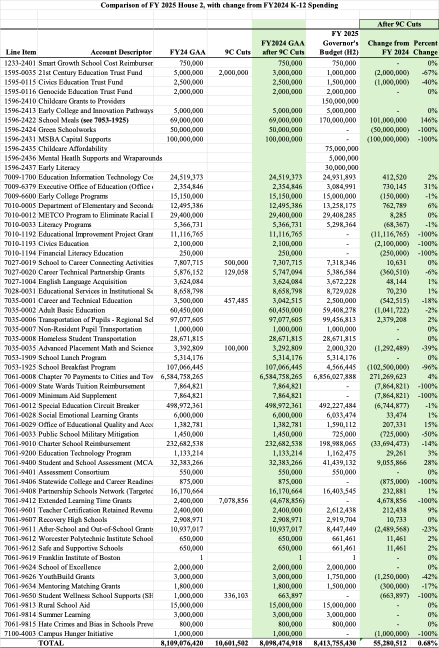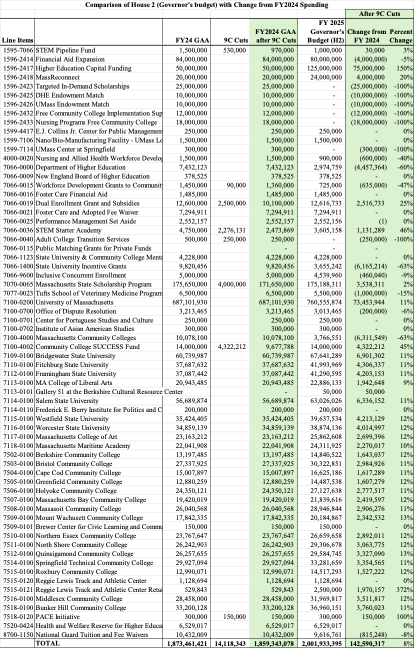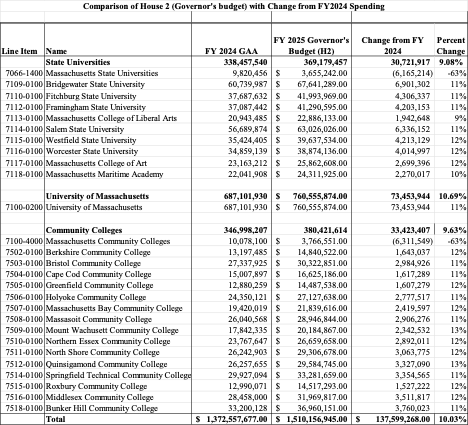Highlights from governor's FY25 budget
Highlights from governor's FY25 budget
House 2 Budget Highlights: Pre-Kindergarten to 12 and Higher Education
Fair Share Funding
The governor’s budget proposal reminds us how important it was that the MTA, other unions, community groups, and so many others campaigned in 2022 to win passage of the Fair Share Amendment. This constitutional amendment taxes multimillionaires and billionaires a little bit more to pay for crucial investments in education and transportation, including universal school meals, free community college for adults 25 and older, significant new scholarship funds for all public college and university students, and much more. In a year when ordinary revenue is barely growing, the governor’s budget proposes new initiatives to support the mental health and social emotional well-being of students and educators who are working effectively to teach all students to read. The budget also provides funds, in line with our Cherish Act for public higher ed, to build and repair campus buildings to meet the needs of students, staff and faculty, and meet the Commonwealth’s climate goals, not to mention funding for an improved MBTA, regional buses and repairs to city and town roads and bridges. MTA members made these investments possible.
This budget, however, proposes only modest steps toward making sure that all of our schools have the resources they need to help all students to thrive, and for a public higher education system that makes debt-free, high-quality public higher education possible for all students in our community colleges, state universities, and at the University of Massachusetts. As a Commonwealth we need to keep pushing forward to make that future a reality. We will look to make further progress as the House and Senate debate the budget for the coming year.
Pre-Kindergarten through 12

- The FY25 governor’s budget proposes a $271 million (4.1%) increase in Chapter 70 aid, for a total of $6.85 billion.
- The charter school reimbursement was reduced from $232 million to approximately $199 million, a 14.5% decline. The reason for this is that few new charter schools have been added and so the number of new first-time students to charter schools has decreased, causing a decrease in tuition reimbursements.
- The special education circuit breaker is fully funded. Because there are still funds available in a reserve created in FY24, the proposed appropriation is less than the appropriation in the FY24 budget.
- The regional school transportation reimbursement account is funded at $99 million, a level that is expected to reimburse 80% of costs.
- The budget proposes an increase for MCAS administration of $9 million, which reflects a new contract with the test company. This amount is expected to include things like translating the tests into multiple languages.
The FY25 House 2 budget proposes new funding for the following:
- Mental health supports and wraparounds ($5 million).
- Child care affordability ($75 million).
- Early literacy ($30 million). This is for a new grant initiative called “Literacy Launch: Reading Success from Age 3 through Grade 3.” Reading and literacy are essential to student success and educators have stated clearly that what they need is more time, funding and flexibility to analyze student needs and respond appropriately. The governor’s grant proposal aligns with many of the policies that MTA educators have been recommending, such as expanded access to professional learning and resources to allow for the adoption and implementation of high-quality curricula materials at the local level. This proposal represents a meaningful step in ensuring that educators have the tools and resources to respond most effectively to students’ unique needs.
The House 2 budget proposes to eliminate funding for several programs including the Educational Improvement Project grants, civics education, and financial literacy education

Higher Education
- The funding levels proposed by the governor for higher education campuses would provide an overall increase of $137 million, or 10 percent more than the FY24 General Appropriations Act. (This is a smaller increase over current spending because there have been supplemental budgets.) Most of this increase is for negotiated collective bargaining agreements.
- The governor proposes to decrease the amount in the formula funding item from $9.8 million to $3.65 million for state universities and from $10 million to $3.76 million for the community colleges.
- The actual funding in the FY24 budget for the Massachusetts State Scholarship program line item, after the $4 million 9C cut, was $171.6 million. The FY25 House 2 budget proposes $175 million, close to the original funding level in the FY24 GAA of $175.6 million.
- The proposed funding for the Financial Aid Expansion (MassGrant Plus Expansion) was reduced from $84 million in FY24 GAA to $80 million in the governor’s FY25 budget.
- The Massachusetts State Scholarship program and the MassGrant Plus Expansion (financial aid expansion) would receive $255 million in the FY25 governor’s proposal. This is lower than the original funding level of $259.6 million in the FY24 GAA.
- The proposed funding for the Community College SUCCESS Fund has been restored to $14 million, which was the original funding level in FY24 GAA. The actual funding in FY24 was lower, at $9.7 million, because of a $4.3 million 9C cut.
- The governor’s FY25 budget proposes to increase the funding for the MassReconnect program by $4 million. The program provides tuition-free community college for students ages 25 and older without a college degree. This program takes us closer to attaining debt-free community college for students in the state.
- The House 2 budget proposes to eliminate funding for several targeted scholarships and programs including the Targeted In-Demand Scholarships, Tomorrow’s Teachers, Free Community College Implementation Supports and the Nursing Program Free Community College, shaving about $70 million from the FY2024 GAA budget.
- $125 million for higher education capital costs.

Retired Members Committee
- The governor’s FY25 budget proposes the typical 3% COLA on the first $13,000 in pension benefits for retired members of the state and teachers’ retirement systems. In addition, the proposal includes the creation of a special commission to study the COLA system. This would include the development of potential policy changes to increase the COLA base and to fund such increases. While we continue to advocate for more immediate steps to strengthen the COLA base, the proposed commission is a positive step and one that reflects the incredible advocacy that MTA Retired members have been applying to this issue in recent years, especially over the past few months.